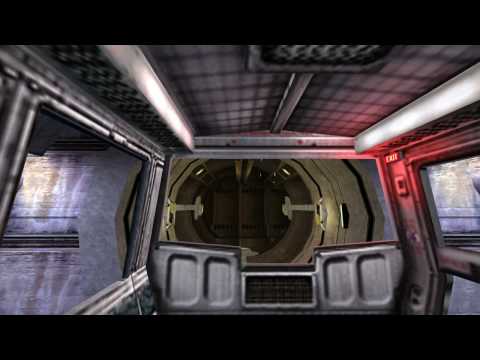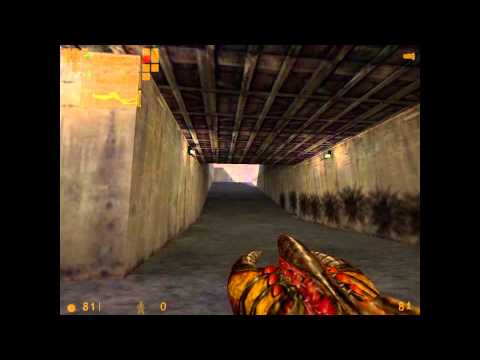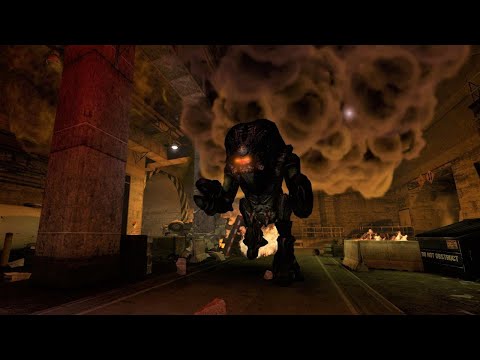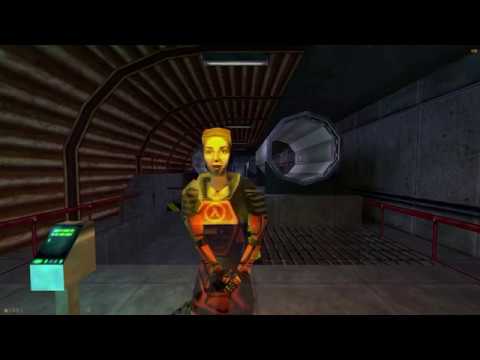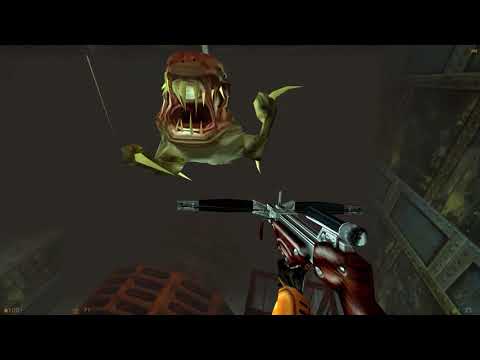Is Half-Life a good game? The complicated answer, 23 years later, is yet. It still is, very much so. The game launched Valve’s most popular franchise. Half-Life 2 followed, and it went on to become one of the best games of all time. Half-Life: Alyx, released last year, focuses on a side character for a memorable VR experience. We’re not talking about the descendants, though. We’re here to see why Half-Life is such a good game. Some would say it’s a masterpiece.
Half-Life Plot
Half-Life is a first-person shooter that breaks the mold. It blends sci-fi elements with thriller and survival-horror for a mesmerizing story about a puppet who believes in his own freedom. You play as an experimental scientist, Gordon Freeman. The scenario is the mysterious, underground Black Mesa laboratory. And the narrative is about you, escaping the facility, once all hell breaks loose. Under New Mexico’s desert, Black Mesa is managing research with questionable ethics. You’re not a significant part of it, though; you’re just a passenger. The game starts with Gordon Freeman waking up on a train cart. The cart travels across the laboratory while ominous music fills the air. Voices from the speakers welcome you to the research facilities, which you get to see for about five minutes. This incredible setup then ramps when Gordon Freeman participates in a dangerous experiment. An “accident” opens up a portal to another world, allowing aliens to crawl into Black Mesa. You, as Gordon Freeman, must escape to the surface.
The puppet Freeman
Such is the main plot, a simple setup that expands on each of the 18 episodes. You must fight your way across corpses, colleagues, puzzles, and hazards to survive. Your talent, plus an ever-expanding, allows you to go above and beyond the scientist and guards, you leave behind. Moreover, as the story expands, you realize there’s something else going on. Someone else is pulling strings behind the curtain. Instead of acting on your own free will, you appear to be a puppet. That’s how the game manages to make a bland canon character. Gordon Freeman has no personality, no will, no voice, and no decisions. You simply do what you’re told, and your actions are often more dangerous than heroic. With this in mind, I have to say the story’s purpose is to enhance the gameplay. Both elements work together to create the experience of scaping Black Mesa as Gordon Freeman.
Evolving gameplay
The brilliance of Half-Life is its gameplay, and I can’t talk about the gameplay without further expanding the story. Both go in service of one another. The game happens during 18 episodes, each one bringing new gameplay mechanics, puzzles, weapons, and challenges. There’s never a dull moment or a repetitive segment. The gameplay keeps evolving and jumping between horror, sci-fi, and full-blown action. During the first episode, you set the events of the accident. Then, with a red wrench in your hand, you must escape from critters and zombified characters. You soon find a pistol to increase your odds of surviving. And with the help of some friends, you devise a plan on how to reach the surface. It’s never as easy, though. Each episode brings puzzles to solve, new weapons to find, and new enemies to combat. They’re both human and alien enemies, and every enemy requires a different approach. Similarly, every weapon works differently. Each one feels unique, fun, and valuable. You’re pushed to use everything you have in your arsenal. That includes, for example, a crazy gun that fires a swarm of flesh-eating creatures. The gunplay is smooth, fun, and creative. Although there’s no cover mechanic, I can say it’s as good as 1998 can be and beyond. Another thing of importance is ammo scarcity, which is where we see it. Missing a single shot of your revolver means trouble down the road. And melting aliens with the laser beam might be fun but wasteful. If you’ve played other survival games like the Resident Evil saga, you’ll understand Half-Life is also a survival-horror title.
Half above, half below
The episodes themselves are more attractive. Each one is uniquely distinct from the previous one, always keeping you on your toes. You can be fighting highly-trained ninjas in a hangar at a time. Five minutes later, you lose your weapons and are forced to survive, with nothing, on a residual plant. Then, the puzzles are not silly mini-games that break the immersion, like we see on most modern titles. Instead, these are about solving particular issues in each area to progress the story. For example, a memorable part of the game is when Gordon Freeman needs to power up an underground rail station to move forward. However, a giant alien is blocking the roads. You need to search the available facilities to find a way to defeat the alien, power up the train and move forward. Like so, every episode is different, fun, engaging, and enjoyable. Oh, I have to say: the game’s name comes from a core gameplay mechanic, or so I think. Part of your playthrough happens beneath the surface, on sewers and plants. Here’s where the horror happens, across dark and humid corridors, bloody rooms, and suffering scientists. The other part of the story happens on the surface. Here, the military and the aliens are fighting, and none of them intend to let you through. Also, the last part of the game is nor here nor there. You actually enter a portal towards Xen, the aliens’ plane of existence, to defeat them once for all. Or so you think!
Performance beyond its time
The game’s visuals, although outdated, were revolutionary by the time. It runs on the GoldSRC engine, a Valve’s solution that imitates Quake’s engine. A couple of years after its debut, it evolved into Source, which runs all of Valve’s games until 2013’s DOTA. That includes a couple of Counter Strikes games, the Left 4 Dead franchise, Portal Portal 2, Team Fortress, Team Fortress 2, etc. In 2015, Source became Source 2, which is Valve’s modern solution. We can say then that GoldSRC had something going on. Valve always breaks barriers regarding visuals and gameplay, and Half-Life’s graphics were their first. Even though the inspiration is Quake’s visuals, Valve’s title looks leagues better. By that time, game reviewers and players praised the game for its graphics, gameplay, and narrative. It also won over 50 PC “Game of the Year” awards, so it stands as one of the best video games in existence. Other awards also praised the music, the art, the graphics, and the performance. So it’s easy to say that Half-Life delivered outstanding visuals and performance for its time. However, the game is now so old that its native resolution is 800 x 800 pixels.
Sound design
Another element to highlight is the soundtrack and sound design. The game runs on memorable original OST that fixes atmospheric horror with industrial techno-rock. It’s such a classic OST that Valve still uses one of these pieces on their logos, as an intro for every Valve game. Also, your journey’s companion is an array of sound effects that are both unique and offputting. Everything sounds like your footsteps, a voice within your suit, the enemies, the weapons, the ambiance, etc. There’s a particular sound when you heal up that I still remember today. In fact, I remember most sounds if I pay attention. Such is the impact the game had on my life. Not only my life, though: these sound effects created the groundwork for Valve’s modern sound design.
Related Question?
Can I play the game right now?
There is. First, you can play Half-Life: Source, available on Steam for Windows PC.Source is a 2003 remaster of the game with the aforementioned Source engine. It delivers graphical and performance upgrades as well as some changes within the episodes. The game is often on sale, which is why it is one of the best Steam games under $20.
Are there any spin-offs?
There’re various Half-Life spin-offs following different characters in the game. Blue Shift follows Gordon, a security officer within Black Mesa; Opposing Force follows a military specialist trying to kill Gordon Freeman. Both games are worthwhile, especially if you’re a Half-Life fan.
Is there a modern version?
There is a modern Half-Life version, a third-party option Valve supported. Crowbar Collective released Black Mesa in 2020 as the remake the game deserves. It’s a fantastic experience that shows a new code of paint that turns the 1998 title into a new masterpiece. However, Crowbar Collective is an indie studio, so Black Mesa is a fan-made remake. It doesn’t have the same production values a true Valve remake could deliver.
How important is Half-Life for Valve?
There’s a before and after Half-Life for both Valve and the gaming industry. Before the game launched, Valve was a small indie developer. After they launched their game, the company became the behemoth it is today. Because of this success, Valve started developing Steam, a store that changed the PC gaming landscape forever. They launched steam in 2003 and the exclusive platform to play 2002’s Half-Life 2.
In conclusion
Half-Life executes its ideas to perfection. It’s a single-player first-person shooter game with a mysterious narration, survival-horror set-pieces, explosive action, and sci-fi plots. All of these elements work, hand in hand, perfectly. Something is lacking, but it’s only a matter of taste. You see, you get to understand the story by paying attention to the environment. The overarching plot reveals conversations, archives, and events. The lack of cutscenes might force you to check a Wiki to understand, but it also shows good faith in the universe Valve created. It delivers an immersive experience that only grows as the gameplay expands. Is Half-Life a good game? Yes, one of the best. I wish for more games like it.

